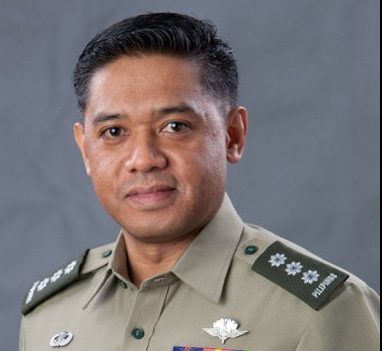Some terrorists in Marawi have sent surrender feelers to military

Col. Romeo Brawner Jr., deputy commander of Joint Task Force Marawi.
MARAWI CITY – Some of the terrorists fighting government troops here since May 23 have sent surrender feelers following military efforts to convince them to yield through public address systems, text messages, and even social media, according to Col. Romeo Brawner Jr., the deputy commander of Joint Task Force Marawi.
Brawner told the Inquirer on Saturday that some Maute gunmen responded to the military’s appeal on Friday.
Brawner clarified, however, that those who intended to yield were only followers of the Maute brothers and Isnilon Hapilon. None of the leaders of the nearly four month siege had signified their intention to surrender, he added.
“We have so far received feelers from their members. (They) wanted to surrender,” he said.
Brawner said the military had responded that the gunmen should also release their hostages – the exact number of whom had not been determined.
“We are also trying to convince them to release their hostages – if not all the hostages, just the women inside the main battle area,” he said.
Brawner did not say how many gunmen had intended to surrender. But he noted that the feelers also came as the military intensified its assault as it aimed to end the crisis, which had so far resulted in the death of 149 military troops and police officers, 47 civilians, and 668 extremists.
Of the total enemy fatalities, 161 were actual body counts, while 507 were “confirmed sniper kills.”
On Friday, Defense Secretary Delfin Lorenzana said that soldiers were close to retaking the entire city, but he declined to give a definite timeline.
“There’s only little resistance left,” he said. “This is just one-half village wide. That’s why I’ve been told by ground commanders that the end is near. Just a little more patience.”
US-trained Filipino troops were among those mobilized as the military made its final push against the extremists.
Equipped with smart night vision goggles, a team of US-trained marines would carefully move in the dark in search of the gunmen.
Earlier, Lt. Col. Jo-Ar Herrera, spokesperson of the Army’s 1st Infantry Division, said the gunmen would engage government troops even in darkness because some of them also had night vision goggles.
Receiving information such – as possible enemy locations from a US-operated P3 Orion hovering above – the military team would move deeper into the main battle area as snipers would shoot at moving objects that carried what resembled a gun.
At a building, where the Inquirer was allowed to stay for the night, along with two photojournalists, the sight of bullets and exploding bombs was very visible.
It was actually a night of explosions and gunfire that catching a sleep was barely possible.
In the morning, the embedded journalists were also allowed to join a clearing operation. Burned or abandoned vehicles were all over the area and the devastation was practically everywhere.
Brig. Gen. Melquiades Ordiales, the commander of the 1st Marine Brigade, said the final push was actually more critical as the gunmen held on to the hostages – including Catholic priest Teresito Suganob.
He said for every inch of the remaining battle area the military tried to take, the resistance was stronger. /atm














